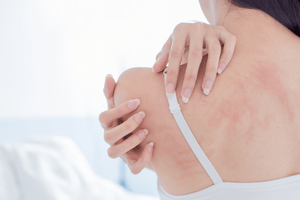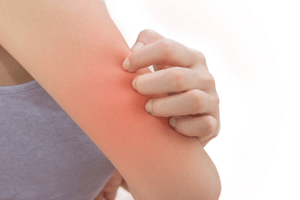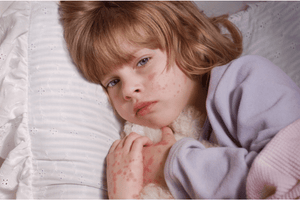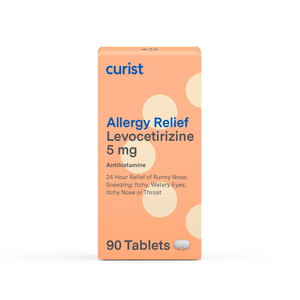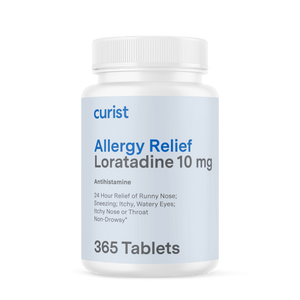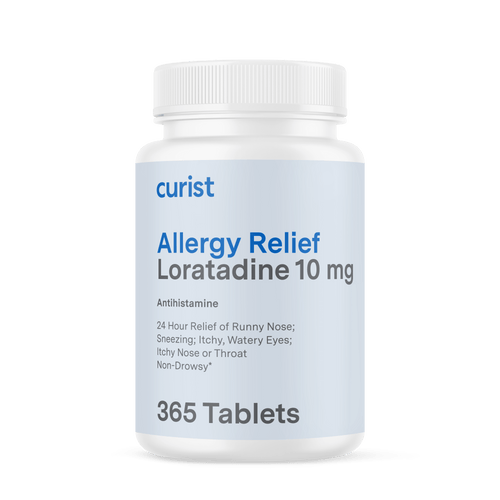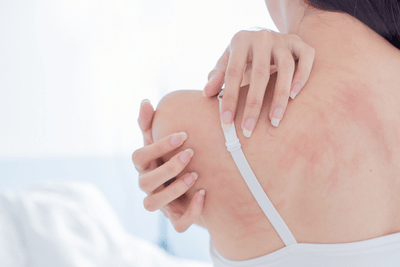Curist delivers over-the-counter medicines to your door at a fraction of the price of traditional brands. We hope everyone stays safe and healthy during this time.
Did you know that an average human sheds up to 1.5 grams of skin flakes every day? These flakes make the perfect home for some unwelcome pests such as dust mites. Can dust mites cause allergies? And what can I do to prevent dust mite bites? Continue reading to learn more about the signs and symptoms of a dust mite allergy and what you can do at home to find relief!
What are Dust Mites? What are the Signs and Symptoms of a Dust Mite Allergy?
Dust mites are microscopic, insect-like pests that live in our skin and feed on the tiny skin flakes of human skin that we shed every day. They love humid and dusty places in our homes such as our bedding, windowsills, and area rugs; therefore, it is important to try to keep these areas as clean and dry as possible.
An allergen is a substance that causes an allergic reaction. Both the body parts and waste of dust mites can act as an allergen, causing allergy symptoms such as itchy eyes, watery eyes, runny nose, sneezing, itchy throat, skin rashes, and or hives. If you also have asthma, dust mites can trigger more severe symptoms such as rapid heart rate, shortness of breath, wheezing, weakness or dizziness. If you experience any of these, you should seek medical attention right away.
In our homes, dust mite allergens usually settle in fabrics, upholstery, carpets, bedding, stuffed animals, curtains, and dusty places rather than staying in the air like cat or dog allergens do. These places may serve as nests for dust mites and trigger your allergy symptoms while you sleep or rest.
How Do I Know If I Am Allergic to Dust Mites? How Do I Know If I Have Allergic Dust Mite Bites?
Asthma, seasonal allergies, and a family history of dust mite allergies may increase your chances of being allergic to dust mites. The main difference between dust mite allergies and hay fever or seasonal allergies is that dust mite allergies are triggered indoors and year round. If you cannot determine your allergies based on your symptoms and environment, visit your local allergy specialist who can help you identify the exact cause of allergy symptoms and discuss the best options for treatment. An allergist may suggest doing a skin prick test (SPT) or a specific IgE blood test to confirm if you have a dust mite allergy.
How Do You Know If You Have Dust Mites on Your Skin?
Dust mites do not leave noticeable bites on your skin, and because dust mites are microscopic in size, it is impossible to see dust mites on your skin without a microscope. If you can see bugs or insect bites on your skin, it may be from a different insect or pest. If you are still unsure, visit a physician or an allergy specialist.
What is the Difference Between Dust Mite Allergy vs Hives?
A dust mite allergy generally causes a variety of allergy symptoms, typically in areas of your face where you may breathe in their allergens (e.g., eyes, nose, or mouth). One such symptom of dust mite allergy is hives. Hives present as red, raised bumps on a large area of your body. Symptoms of dust mite allergies usually present as itchy eyes, watery eyes, runny nose, sneezing, itchy throat, skin rashes, and hives. Many allergens such as pet dander, pollen, certain medications, infection, foods, exercise, stress, heat, or alcohol can all trigger hives.
If you experience difficulty breathing, dizziness, or swelling inside your throat, tongue, eyes, or lips with hives, this may indicate an anaphylaxis reaction, a serious life-threatening allergic reaction, and you should seek medical attention right away.
What is the Difference Between Dust Mite Allergy vs Bed Bug Bites?
Bed bugs and dust mites both live in mattresses, so it is important to identify which ones are bothering you. Here are some distinct differences between dust mites versus bed bugs:
- Dust mites eat dead human or pet skin flakes, while bed bugs drink human blood.
- Dust mites like humid places, thrive in temperatures between 68-77°F, and die at extreme temperatures, unlike bed bugs which can survive in temperatures as low as 46°F.
- Adult bed bugs are visible to the eye, about the size of an apple seed, while dust mites are microscopic, roughly ¼ or ⅓ of a millimeter, and are not visible to the eye.
The main difference in dust mite allergy versus bed bug bites is in the symptoms. Bed bug bites usually present as swollen red bites and appear in a group or line on uncovered areas of skin after you sleep on furniture with bed bugs. Dust mites do not usually cause red bumps. More often, dust mite allergy symptoms include itchy eyes, watery eyes, runny nose, sneezing, itchy throat, skin rashes, and/or hives.
Regardless of whether you have bed bug bites or dust mite allergies, it is important to clean your home to remove them. To avoid bed bugs, carefully inspect any bedding, sofas, chair cushions, and furniture at hotels or new lodgings first before laying or sitting down. If you question the cleanliness of a facility or notice any visible bugs, avoid using the furniture. If you notice a bedbug infestation, contact a professional to handle the situation. To clean your home of dust mites, try removing carpets and upholstered furniture and do regular cleanings. You may also find yourself in the over-the-counter (OTC) allergy aisle of the pharmacy seeking for additional relief from dust mite allergies.
Do I Have Dust Mite Allergy or Eczema?
Eczema is a skin condition where you may find red, brown, or gray dry, crusty patches on your skin, causing a bumpy texture. These bumps may be more itchy at night or filled with fluid. If you scratch your eczema, the bumps may become infected and painful. Dust mite allergy is different than eczema as dust mite allergies usually present as typical allergy symptoms (i.e. itchy eyes, runny nose, sneezing). While there are many strategies listed below that can help prevent dust mite allergies, eczema usually requires a visit to your physician or dermatologist to determine the best medication in managing your eczema.
How Do I Prevent Dust Mite Allergy? How Do I Stop Being Allergic to Dust Mites?
Use the tips and tricks below to help control your dust mite allergies at home:
- Reduce the humidity: Keep the humidity at or lower than 50% because dust mites love moisture and absorb moisture from the air to survive.
- Mask while vacuuming: Vacuuming can stir allergens and dust into the air, so wearing a mask during and for 20 minutes afterwards can help reduce your symptoms. Depending on your vacuum, you may be able to use a HEPA filter or double-layered microfilter bag to help improve the quality of your indoor air.
- Trap the dust mites while cleaning: Dusting regularly with a wet washcloth, damp mop, or microfiber cloth will trap dust and dust mites while cleaning to make the air quality in your home better. Avoid dry rags since this can stir up the dust into the air.
- Cover your bases: Use dust-proof pillow and mattress covers on beds.
- Choose washable bedding and stuffed animals: Try to reduce the amount of clutter and stuffed animals, but we understand that your kids may not agree with losing teddy. Instead, weekly “baths” in hot water (130℉) can kill and clean dust mites off of precious stuffed animals. Likewise, bedding and blankets should be washed regularly.
- Remove their nesting grounds: If possible, replace carpeting with hardwood or bare floors, remove fabric curtains, drapes, and carpets, and switch upholstered furniture with those that have smooth surfaces so it is difficult for dust mites to find a home.
Using the tips above may help you prevent some of your dust mite allergy symptoms; however, if you need some additional relief, there are also several options for over-the-counter medications available at your local pharmacy or here at Curist that may help you find additional relief if necessary.
What is the Best Treatment for Dust Mite Rash?
Since dust mites do not bite, how can dust mites cause a rash? This is a great question! When you inhale proteins that are released from dust mites, it can cause inflammation and allergic dermatitis (rash). If you are pretty sure that dust mites are the cause of your skin rash, use preventative measures such as regular cleanings to avoid exposure to dust mites.
In the case that you are unsure the exact cause of your rash, it may be a sign of an allergic reaction known as contact dermatitis. Typically the rash is a result of contact with an irritating substance or allergen. This can include plants, pesticides, medication, pollen, perfume, bleach, detergents, or chemicals. If your rash does not get better with time, worsens, or makes it difficult to breathe, you should seek immediate medical attention.
What is the Best Dust Mite Allergy Medicine?
There are many options over-the-counter for relief from dust mite allergy symptoms. It is going to take some time for you to identify the best dust mite allergy medicine, and keep in mind that it may also change over time. Some of the best medicines for dust mite allergy are available at Curist and at your local pharmacy:
- Oral or Intranasal Antihistamines: Antihistamines, such as Curist Allergy Relief (levocetirizine) are perhaps the best first line treatment for dust mite allergy. Antihistamines can help relieve sneezing, runny nose, and itching symptoms. Antihistamines are available as oral tablets, Curist Allergy Relief (levocetirizine) or fexofenadine, or as intranasal sprays like olopatadine (Patanase) and azelastine (Astelin).
- Intranasal Corticosteroids: To reduce the swelling and inflammation caused by allergies in your nose, you may find Curist Allergy Nasal Spray (fluticasone propionate 50 mcg), mometasone furoate (Nasonex), or triamcinolone (Nasacort Allergy 24 hours) to be useful.
- Oral or Intranasal Decongestants: For a short period of time (< 3 days), intranasal decongestants may help you breathe better through your nose. However, it is important to note that oral decongestants may cause elevations in blood pressure, glaucoma, or sleepiness, therefore it is important to discuss with a healthcare professional first prior to using decongestants.
- Nasal Irrigation: Using a neti pot and saline rinse can help flush mucus from your sinuses, but be sure to follow the instructions in the product description (i.e., using distilled, sterile water).
- Allergy shots and tablets: Subcutaneous immunotherapy (SCIT) or sublingual immunotherapy (SLIT) can also help “train” your immune system against dust mites. Typically this would require a visit and discussion with your physician or an allergy specialist.

